ABOARD USS WASP: The continuous sorties of F-35Bs flying on May 26, watched by British and US press, was almost numbing. Six planes aboard the ship flew sortie after sortie, four from the Green Knights squadron at Yuma and two from the Warlords at Beaufort.
As Lt. General Davis, deputy Marine Commandant for aviation, said in response to a question about the date for Initial Operating Capability (IOC) of the F-35B: “It will be this summer. We are clearly focused on July. But it is in the hands of the professionals and they are making it happen.”
The professionals he had in mind are maintainers from three squadrons, the Green Knights (Yuma), the Warlords (Beaufort) and VMX-22 (New River). The ship’s executive officer (XO), Capt. Andrew “Mongo” Smith, highlighted the ability of a 25-year-old ship to become part of fifth generation warfare and operate the F-35 showed the flexibility of both the ship and the Navy-Marine Corps team.
One of the Marine pilots involved with the ship integration-testing said:
“No one in the world has ever sent an airplane off of an amphibious ship with this level of situational awareness and fusion between aircraft to aircraft and aircraft to ship. The fusion of the data aboard the airplanes and your ability to see what other planes are seeing a number of miles away from you, as well as what the ship is seeing, and then to be able to communicate with them without using the radio is a tactical and strategic advantage that can not really be over stated.”
Together, the Navy-Marine Corps team is transforming the Gator Navy, which has historically operated amphibious ships for assault by helos, amphibious vehicles, and infantry, to one that can assault from sea at great distances. It is turning what was a Greyhound Bus role to shaping an entirely new strike capability appropriate for 21st century operations. It began with the introduction of the Osprey and is being empowered by the integration of the F-35B with the Marine Corps force.
This change was presaged in a Marine Corps exercise last year involving San Clemente Island. Operating from the training base in Twentynine Palms and landing on California’s San Clemente Island, approximately 100 students from the Infantry Officer Course in Quantico flew aboard Ospreys to eliminate cruise missile threats and take back an airfield from enemy forces.
The Infantry Officer Course at Quantico paired with VMX-22 conducted the exercise and the Ospreys were accompanied by specially configured Ospreys using an airborne Wi-Fi network that linked the tables carried by the squads riding in the Ospreys. The Cat Bird, the F-35 surrogate sensor aircraft, sent maps and images as well as text messages about the objective to the Marines as they flew.
The Ospreys carried the force; the F-35 surrogate provided the cover so the force could be inserted more effectively. This is how the Marines are looking at a key aspect of the F-35 approach to providing close air support for a 21st century ground insertion force.
The CO of VMX-22, Col. “Horse” Rauenhorst highlighted that their work as a squadron was focusing on the integration of the Osprey, the F-35 and the new CH-53K helicopter as key elements to create a more lethal and survivable MAGTF. The infantry Marine forces can be inserted at greater distance, with greater flexibility to enhance their effectiveness and survivability. That is the whole point of the innovation being tested aboard the USS Wasp.
One aspect of the effort for ship integration of the F-35B aboard the ship was maintenance at sea. Maintainers from the three squadrons – the Green Knights from Yuma, the Warlords from Beaufort, and those from VMX-22 – worked together for the first time aboard the ship. And according to the maintainers their approach worked very well.
The report from the team aboard the ship was straightforward: “we could maintain the plane on ship very well and saw no loss of capability compared to maintaining the plane ashore.”
The Brits were aboard as well and are training with the Marines at Beaufort, S.C., the base where all foreign F-35B pilots and the foreign maintainers as well. The Italians will be coming next; both the Italian Navy and Air Force will operate F-35Bs.
I have now had a chance to visit all three new large deck ships where the F-35 will play a key role: the HMS Queen Elizabeth on March 31 in Scotland; earlier aboard the USS America, and the CVN-78 (Gerald Ford). The British carrier is designed for the F-35B and the engagement of the Royal Navy and Royal Air Force with the Marines and the Navy is very significant, and personnel clearly were looking for lessons learned aboard the ship to integrate with the standing up of the new class of the UK’s very innovative carriers which the United Kingdom is building.
Lt. Cdr. Neil Mathieson and Lt. Cdr. Beth Kitchen represented the Royal Navy. Mathieson was visiting the ship and returning to the UK with lessons learned; Kitchen is based at Beaufort and is an integral part of the Royal Navy-Marine team, notably with regard to rolling out the maintenance process and effort.
“The F-35 can be surrounded by myth and legend. But it is a real testimony to the capabilities of the maintainers of the Royal Navy, the Royal Air Force and the USMC to adapt to the new technological challenges,” Kitchen said. “Their knowledge of aircraft systems is now being applied to a new air system and taking steps forward into the unknown. It is a testament to the professionalism of these maintainers that they are just getting on with the job of making this aircraft work. Every single person involved in this detachment are passionate about this aircraft — and not just because it is a sexy looking aircraft — but they want to see it working in every operational environment.”
Army inching towards late FY25 Chinook Block II full-rate production contract
Boeing recently announced the Block II helo’s first maiden flight and plans to deliver the first production aircraft to the service in the coming weeks.



























